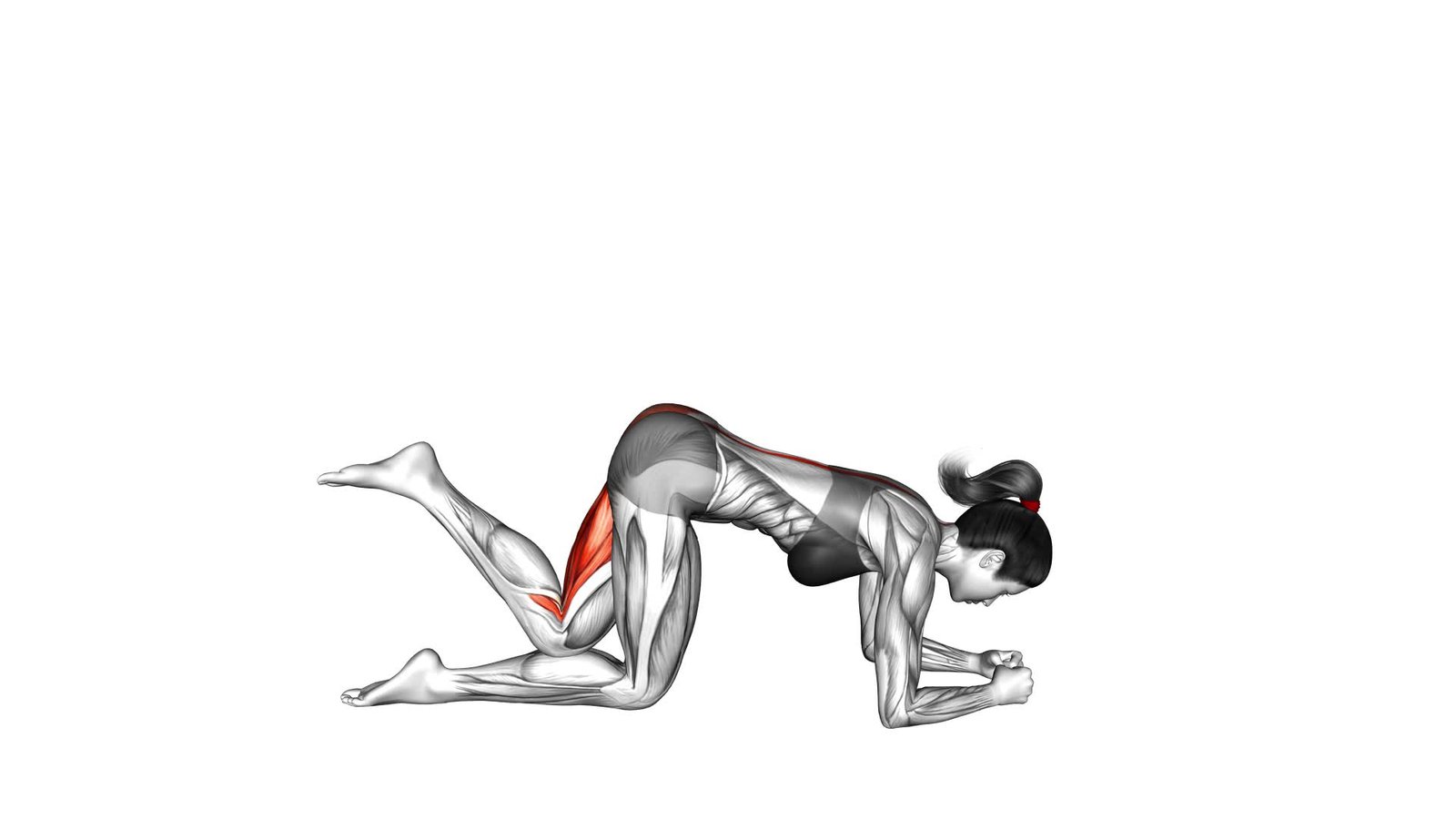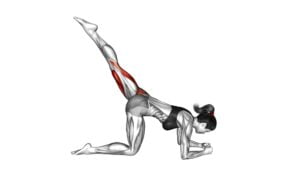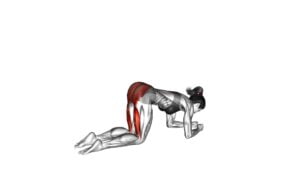Basic to Cross Donkey Kick (female) – Video Exercise Guide & Tips

Get ready to kick up your workout routine with the Basic to Cross Donkey Kick!
Watch This Exercise Video
This female-focused exercise is a great way to target your glutes and core while improving overall strength and stability.
In this video exercise guide, we'll show you the proper form and technique, as well as modifications and progressions to challenge yourself.
Say goodbye to common mistakes and hello to a more effective workout.
Let's get started!
Key Takeaways
- Basic to Cross Donkey Kick exercise targets glutes, hamstrings, and core muscles.
- Glute activation exercises improve overall strength, athletic performance, and prevent injuries.
- Donkey kick variations provide a challenging workout for the glutes and can be modified for different fitness levels.
- Consistency and progression are important for better results in glute development.
Benefits of Basic to Cross Donkey Kick
You can experience several benefits by incorporating the Basic to Cross Donkey Kick into your workout routine. This exercise primarily targets your glutes, hamstrings, and core muscles, helping you build a stronger and more toned lower body. The explosive movement involved in the donkey kick helps improve your power and explosiveness, making it a great exercise for athletes looking to enhance their performance.
Additionally, the donkey kick can help improve your balance and stability, as it requires you to engage your core to maintain proper form.
One of the great things about the Basic to Cross Donkey Kick is that there are various variations you can try to keep your workouts challenging and exciting. For instance, you can add ankle weights to increase the resistance and intensify the workout. Another variation is the single-leg donkey kick, where you perform the exercise with one leg at a time, targeting each glute individually. You can also experiment with different tempos and ranges of motion to target different muscle fibers and stimulate further muscle growth.
Now that you know the benefits and variations of the Basic to Cross Donkey Kick, let's move on to discussing the proper form and technique for this exercise.
Proper Form and Technique for Basic to Cross Donkey Kick
To perform the Basic to Cross Donkey Kick with proper form and technique, focus on engaging your glutes, hamstrings, and core muscles throughout the movement. This exercise targets these specific muscle groups and helps to strengthen and tone them.
Start by getting down on all fours with your hands directly under your shoulders and your knees hip-width apart. Keep your spine neutral and engage your core by pulling your belly button towards your spine.
Begin the movement by lifting one leg up towards the ceiling, keeping it bent at a 90-degree angle. As you raise your leg, focus on squeezing your glutes and hamstrings.
Once your leg is fully extended, cross it over your opposite leg, tapping your foot on the floor. This will engage your core even more.
Return your leg to the starting position and repeat the movement on the other side. Remember to keep your movements controlled and avoid arching your back.
By performing the Basic to Cross Donkey Kick with proper form and technique, you'll maximize the benefits of this exercise and see improvements in your glute, hamstring, and core strength.
Now, let's move on to the modifications and progressions for the Basic to Cross Donkey Kick.
Modifications and Progressions for Basic to Cross Donkey Kick
To modify or progress the Basic to Cross Donkey Kick exercise, you can incorporate variations that challenge your muscles in different ways. Here are some modifications and advanced variations you can try:
- Single-Leg Donkey Kick: Instead of using both legs, perform the exercise with one leg at a time. This increases the intensity and puts more focus on the glutes and hamstrings of the working leg.
- Weighted Donkey Kick: To add resistance and make the exercise more challenging, you can hold a dumbbell or kettlebell behind your knee while performing the donkey kick. This helps to strengthen and tone the muscles even more.
- Cross Donkey Kick with Knee Tuck: After performing the cross donkey kick, bring your knee towards your chest, engaging your core muscles. This adds an extra element of stability and balance while targeting your abs and hip flexors.
By incorporating these modifications and advanced variations into your workout routine, you can continue to challenge your muscles and take your donkey kicks to the next level. Remember to listen to your body and start with modifications that suit your fitness level, gradually progressing as your strength improves.
Keep pushing yourself and enjoy the benefits of this effective exercise.
Common Mistakes to Avoid During Basic to Cross Donkey Kick
One common mistake to avoid during the Basic to Cross Donkey Kick exercise is improper hip alignment. It's important to maintain proper form to maximize the effectiveness of this exercise and minimize the risk of injury. When performing the Basic to Cross Donkey Kick, make sure to keep your hips squared and aligned with your shoulders. Avoid allowing your hips to rotate or twist, as this can lead to strain on the lower back and decrease the efficiency of the movement.
To maintain proper hip alignment, engage your core muscles throughout the exercise and focus on keeping your hips stable and level.
Another common mistake is using momentum instead of controlled movements. It's important to perform the Basic to Cross Donkey Kick with slow, controlled motions to fully engage your glutes and hamstrings. Avoid swinging your leg or relying on momentum to lift it up. Instead, focus on using the muscles in your buttocks to lift your leg while keeping your core stable.
By performing the exercise with proper form and controlled movements, you'll target the intended muscles and avoid potential strain or injury.
Now that you're aware of the common mistakes to avoid during the Basic to Cross Donkey Kick, let's move on to the next section where we'll provide you with tips for incorporating this exercise into your workout routine.
Tips for Incorporating Basic to Cross Donkey Kick Into Your Workout Routine
To effectively incorporate the Basic to Cross Donkey Kick into your workout routine, focus on consistency and progression. Here are some tips to help you get the most out of this exercise and maximize your glute activation:
- Start with the basics: Before attempting the cross variation, make sure you have mastered the basic donkey kick. This will ensure proper form and help prevent injury.
- Gradually increase intensity: Once you feel comfortable with the basic donkey kick, you can start incorporating variations, such as the cross movement. This will challenge your glutes in different ways and keep your workout interesting.
- Mix it up: While the donkey kick is an effective exercise for glute activation, it's important to vary your routine to target all areas of your glutes. Incorporate other exercises like lunges, squats, and hip thrusts to keep your glutes guessing and promote overall strength and development.
Remember, incorporating donkey kick variations and alternative exercises for glute activation can help you achieve better results. By staying consistent with your workouts and progressively challenging yourself, you'll be on your way to stronger, more toned glutes in no time.
Keep pushing yourself and enjoy the journey to a stronger you!
Frequently Asked Questions
Can Men Also Perform the Basic to Cross Donkey Kick Exercise?
Yes, men can definitely perform the basic to cross donkey kick exercise!
Donkey kicks are a great way to work your glutes and improve overall lower body strength.
There are various variations of donkey kick exercises that can be done by both men and women to target different muscle groups.
So don't hesitate to add this exercise to your routine and feel the burn!
Keep pushing yourself to reach your fitness goals.
Is It Necessary to Warm up Before Doing the Basic to Cross Donkey Kick?
Before jumping into the Basic to Cross Donkey Kick, it's important to warm up your muscles. Warming up helps increase blood flow and flexibility, reducing the risk of injury. It also prepares your body for the exercise, allowing you to perform at your best.
How Many Calories Can You Burn by Doing the Basic to Cross Donkey Kick?
By doing the basic to cross donkey kick, you can burn a good amount of calories. This exercise not only helps you shed those extra calories, but it also has great benefits for your glutes.
It targets and tones your glute muscles, giving you a firm and sculpted backside.
Can the Basic to Cross Donkey Kick Help in Toning the Abs?
The basic to cross donkey kick is a great exercise for toning your abs and improving core strength. By engaging your abdominal muscles and stabilizing your body, this exercise targets the core and can help sculpt a defined midsection.
Adding this move to your fitness routine can be highly effective in achieving a toned and strong core. So get ready to kick those abs into shape!
Is It Safe to Perform the Basic to Cross Donkey Kick if You Have a Lower Back Injury?
If you have a lower back injury, it may not be safe to perform the basic to cross donkey kick. It's important to listen to your body and consult with a healthcare professional before attempting any exercise.
There are modifications you can make to the basic to cross donkey kick to accommodate your lower back injury, such as reducing the range of motion or using a stability ball.
Alternatively, you can try other exercises that target the same muscle groups without putting strain on your lower back.
Conclusion
Incorporating the basic to cross donkey kick into your workout routine can provide numerous benefits, including strengthening your glutes, hamstrings, and core muscles.
By maintaining proper form and avoiding common mistakes, you can maximize the effectiveness of this exercise.
With modifications and progressions, you can tailor the donkey kick to your fitness level.
So, get ready to kick it up a notch and add this dynamic move to your fitness routine for a stronger and more toned lower body.

Author
Years ago, the spark of my life’s passion ignited in my mind the moment I stepped into the local gym for the first time. The inaugural bead of perspiration, the initial endeavor, the very first surge of endorphins, and a sense of pride that washed over me post-workout marked the beginning of my deep-seated interest in strength sports, fitness, and sports nutrition. This very curiosity blossomed rapidly into a profound fascination, propelling me to earn a Master’s degree in Physical Education from the Academy of Physical Education in Krakow, followed by a Sports Manager diploma from the Jagiellonian University. My journey of growth led me to gain more specialized qualifications, such as being a certified personal trainer with a focus on sports dietetics, a lifeguard, and an instructor for wellness and corrective gymnastics. Theoretical knowledge paired seamlessly with practical experience, reinforcing my belief that the transformation of individuals under my guidance was also a reflection of my personal growth. This belief holds true even today. Each day, I strive to push the boundaries and explore new realms. These realms gently elevate me to greater heights. The unique combination of passion for my field and the continuous quest for growth fuels my drive to break new ground.







